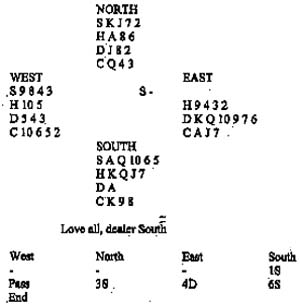|
BRIDGE
 SOUTH
had only 18 points, itís true, but his loser-count was just four
(one in each of the majors, two in clubs), so prospects for a slam
were good. Also, Eastís 4D suggested that North would have little
wasted in diamonds, opposite the bare ace. A diamond was led to the
ace and declarer cashed the ace of trumps, discovering the 4-0 break.
How would you have continued? If trumps had been 3-1 or 2-2, you could
simply have thrown a club from dummy on the fourth heart, given up a
club, and ruffed a club for your twelth trick. The 4-0 trump break
prevents you from doing this (unless West also has four hearts and
will have to follow suit all the way). A better idea is to reverse the
dummy, ruffing two diamonds in the South hand, drawing trumps in the
North hand, and eventually throwing one of Northís clubs on your
last heart. At Trick 2 you play a spade to the 8 and jack. You then
ruff a diamond high and lead the club king, which East will probably
duck. A heart to the ace is followed by a second high diamond ruff.
You then play a low trump to dummyís 7, draw the last trump, and
score three more hearts for the contract. SOUTH
had only 18 points, itís true, but his loser-count was just four
(one in each of the majors, two in clubs), so prospects for a slam
were good. Also, Eastís 4D suggested that North would have little
wasted in diamonds, opposite the bare ace. A diamond was led to the
ace and declarer cashed the ace of trumps, discovering the 4-0 break.
How would you have continued? If trumps had been 3-1 or 2-2, you could
simply have thrown a club from dummy on the fourth heart, given up a
club, and ruffed a club for your twelth trick. The 4-0 trump break
prevents you from doing this (unless West also has four hearts and
will have to follow suit all the way). A better idea is to reverse the
dummy, ruffing two diamonds in the South hand, drawing trumps in the
North hand, and eventually throwing one of Northís clubs on your
last heart. At Trick 2 you play a spade to the 8 and jack. You then
ruff a diamond high and lead the club king, which East will probably
duck. A heart to the ace is followed by a second high diamond ruff.
You then play a low trump to dummyís 7, draw the last trump, and
score three more hearts for the contract.
 What
would you say now on the West cards? What
would you say now on the West cards?
Answer
A raise to 3D would be
non-forcing, so you cannot risk that. The same is true of 3S, which is
again non-forcing. To bid 3NT without a club stopper is too much of a
gamble. The best idea is to show your strength with a bid in the
fourth suit (3C). After partnerís response you will have a much
better idea which game (or slam) will be best.
Awards: 3C (fourth
suit)-10, 4D/3NT-6, 3S/3D-3.
David Bird
ó Knight Features
|